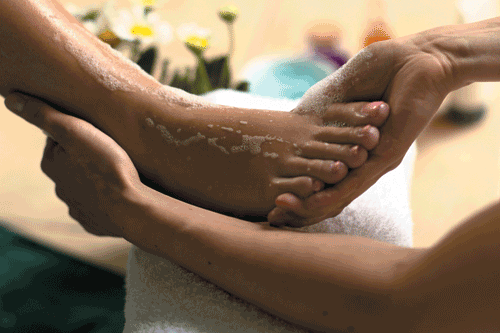
Ayurvedic Foot Massage
Ayurveda is an ancient Indian medical system, meaning ‘science of life ‘the art of harmonious healthy living. Ayurveda explains that human beings, like the universe, are made up of five elements: air, fire, water, earth and space and focuses on the maintenance of physical, emotional and spiritual balance.
The marmas (vital energy points) are an important part of Ayurvedic anatomy. As with reflexology, these points correspond to internal organs and systems of the body and are worked on in all Ayurvedic treatments. There are 107 marma points, which form vital energy channels running throughout the body; some of these points are located on the legs and feet.
Ayurvedic foot massage is carried out with the use of a small three-metal bowl (vatki) or a wand, comprising a bowl with a handle attached. The metals used are copper, zinc and tin, and this sacred metal alloy (kansa) is known in Ayurveda as the ‘healing metal’. It is thought that copper may help in reducing pain and inflammation, zinc in aiding the digestive and immune systems, and tin in improving digestion and reducing headaches and insomnia.
What to expect
The treatment begins by cleansing the feet and legs. This is followed by specific moves to release tension in the feet and legs. Then, slowly and methodically, the entire feet and lower legs (toes, feet, ankles, calves and knees) are encouraged to relax through the application of massage techniques carried out with the aid of oil.
The treatment incorporates special moves performed using the kansa bowl or wand.
Ayurvedic foot massage is a wonderfully relaxing holistic treatment that can help balance body, mind and spirit.

Spa Pedicure
Your pedicure will start with your feet being massaged with a peppermint foot cream and placed in heated booties to help relaxation and encourage flexibility and to aid in hydration and conditioning.
The therapist will then work on the first foot, keeping the other well wrapped and warm. All traces of old polish will be removed and then your nails cut with clippers and gently filed straight across. Shaping into the sides is not good as it encourages ingrown toenails as small slivers of nail could be left behind.
Patches of hard skin tend to build up in areas that get the most pressure such as the soles of the feet and the heels. This is easy to remove with an implement called a callous file or the therapist may massage the area with a cream especially made for the purpose.
Cuticles are the next areas to receive attention. Cuticle cream is first massaged in and then cuticle nippers are used to remove any ragged edges.
The therapist will then start to massage your feet with a cream or oil, which helps relaxation and encourages flexibility and to aid in hydration and conditioning.
To finish, the nails can be painted with a polish of your choice.

Reflexology
Reflexology is a non-invasive complementary health therapy that can be effective in promoting deep relaxation and wellbeing; by reducing stress in people’s lives can be key in optimising good health and building resilience. It is a touch therapy that is based on the theory that different points on the feet, lower leg, hands, face or ears correspond with different areas of the body and reflexologists work these points and areas.
Is reflexology suitable for me?
Reflexology is a therapy which can be received by anyone at any age, from newborn babies to those receiving end of life care, and everyone in between. However, there may occasionally be times when it is not suitable to provide a treatment. The best advice we can give you is to give your local reflexologist a ring and ask! Please note: reflexology should not be used as an alternative to seeking medical advice.
Will reflexology help me?
Well trained reflexologists do not claim to cure, diagnose or prescribe. Reflexology is a very individual treatment which is tailored to you as a whole person, taking into account both physical and non-physical factors that might be affecting your wellbeing. Some people find it works for them – some don’t. The best way to find out is to try it!
The theory is that reflexology helps the body to restore its balance naturally. Usually, after a treatment your tension may be reduced and you might feel relaxed. You might also notice yourself sleeping better and find your mood and sense of wellbeing improving. You may also find that other aspects improve too; however, this happens on an individual basis.
What happens when I go for a treatment?
A full medical history will be requested on your first treatment, and you will be asked to sign a consent form for treatment. This information will be kept confidential. Reflexology is a very easy therapy to receive; depending on the type of reflexology, the most clothing that will have to be removed for a treatment to take place will be your socks and shoes.
The therapist will then use their hands to apply pressure to the feet, lower leg, hands, ears or face, depending on the type of reflexology chosen. You may feel areas of transient discomfort during the treatment, but generally the experience should be relaxing.
How will I feel after a reflexology treatment?
It is useful to give feedback to the reflexologist as this may show the response of your body to treatment. This in turn might help the reflexologist to tailor a treatment plan specific to your needs. After one or two treatments your body may respond in a very noticeable way. Most people note a sense of well-being and relaxation; however, sometimes people report feeling lethargic, nauseous or tearful, but this is usually transitory and reflexologists believe that it is part of the healing process.
